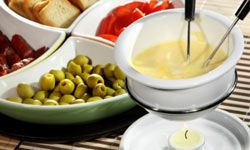Gooey, creamy, lip-smacking cheese -- what more could you ask for in a comfort food? Chocolate, you say. Actually, chocolate and cheese make an ideal marriage -- think chocolate cheesecake. And in New Zealand, they make a chocolate cheese that has taken Asia by storm [source: Chan]. Yes, chocolate cheese. That's probably not a flavor the first cheese makers considered.
Primitive cheese making dates back as far as 8000 B.C. [source: Brown]. European monks have made cheese since the Middle Ages, and some monasteries continue the tradition today. But it was not until the mid-19th century that cheese making became a full-fledged industry [source: The Dairy Research & Information Center].
Advertisement
Today, there are more than 400 varieties of cheese [source: The Dairy Research & Information Center]. You can choose from an array of hard smoked, semi-firm, semi-soft and soft cheeses. In the dairy case, you'll find cheddar, Camembert and chèvre, Edam and Emmental, Gouda and Gruyere, Havarti, Manchego, mozzarella and mascarpone, Parmigiano-Reggiano, Pecorino and provolone, a variety of blue cheeses and many others.
In 2007, Americans ate 32.7 pounds of cheese per capita. Greece weighed in at number one, consuming 82.2 pounds, with France running a distant second at 51.9 pounds [source: Wisconsin Milk Marketing Board].
Besides being tasty, cheese can also be nutritious -- it contains calcium and protein as well as fat-soluble vitamins and minerals. And there's good news for those of you who are lactose intolerant: Cheese contains minimal lactose, so even if you can't tolerate milk, you probably can indulge in cheese [source: U.S. Dairy Export Council].
Come along as we travel through time, exploring the mystique, the myths and the lore of the top 10 favorite cheesy dishes.





